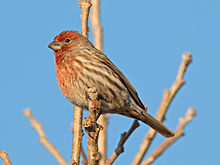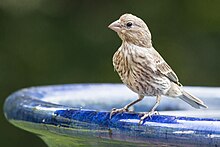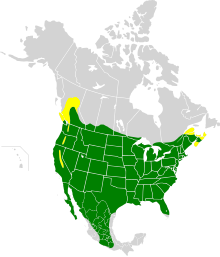House finch
| House finch | |
|---|---|
 |
|
| Adult male | |
 |
|
| Adult female | |
| Scientific classification | |
| Kingdom: | Animalia |
| Phylum: | Chordata |
| Class: | Aves |
| Order: | Passeriformes |
| Family: | Fringillidae |
| Subfamily: | Carduelinae |
| Genus: | Haemorhous |
| Species: | H. mexicanus |
| Binomial name | |
|
Haemorhous mexicanus (Müller, 1776) |
|
 |
|
| Range of H. mexicanus Breeding range Year-round range | |
| Synonyms | |
|
|
The house finch (Haemorhous mexicanus) is a bird in the finch family Fringillidae. It is native to western North America, and has been introduced to the eastern half of the continent and Hawaii. This species and the other "American rosefinches" are placed in the genus Haemorhous.
This is a moderately-sized finch. Adult birds are 12.5 to 15 cm (4.9 to 5.9 in) and span 20 to 25 cm (7.9 to 9.8 in). Body mass can vary from 16 to 27 g (0.56 to 0.95 oz), with an average weight of 21 g (0.74 oz). Among standard measurements, the wing chord is 7 to 8.4 cm (2.8 to 3.3 in), the tail is 5.7 to 6.5 cm (2.2 to 2.6 in), the culmen is 0.9 to 1.1 cm (0.35 to 0.43 in) and the tarsus is 1.6 to 1.8 cm (0.63 to 0.71 in). Adults have a long, square-tipped brown tail and are a brown or dull-brown color across the back with some shading into deep gray on the wing feathers. Breast and belly feathers may be streaked; the flanks usually are. In most cases, adult males' heads, necks and shoulders are reddish. This color sometimes extends to the belly and down the back, between the wings. Male coloration varies in intensity with the seasons and is derived from the berries and fruits in its diet. As a result, the colors range from pale straw-yellow through bright orange (both rare) to deep, intense red. Adult females have brown upperparts and streaked underparts.
Their song is a rapid, cheery warble or a variety of chirps.
This bird belongs to the genus Haemorhous, together with the purple finch and Cassin's finch. These three species are not closely related to the Old World Carpodacus rosefinches.
These birds are mainly permanent residents throughout their range; some northern and eastern birds migrate south. Their breeding habitat is urban and suburban areas across North America, as well as various semi-open areas in the west from southern Canada to the Mexican state of Oaxaca; the population in central Chiapas may be descended from escaped cagebirds.
...
Wikipedia

